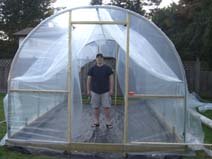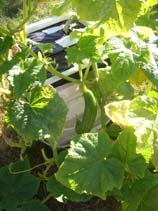|
Greenhouse Covers - which one is "Right" for your Greenhouse Build? Take a look at the options.There are a number of things to keep in mind when choosing the right Greenhouse Covers for your greenhouse project. And in that, there are a few different Greenhouse Glazing to choose from. The covering is the most essential, and most expensive, part of the greenhouse. The cover traps the heat and humidity in the greenhouse, and keep the pests out. All parts of a Greenhouse come together in playing a role, however, the cover is the most important by far. Here is a list of some of the available materials that can be used to cover your greenhouse:Greenhouse Glass
Poly Film – Greenhouse Plastic Covering
Greenhouse Polycarbonate
Plexiglass
Shade Clothe
Or simply secure the shade clothe over top of the poly plastic. Pop Bottles
Want to know what the greenhouse cover or glazing does? than be sure to check out the video below - I couldn’t get the song out of my head : ) There are a number of different frames to choose from when deciding on a Greenhouse. A good place for some ideas of the materials that you would to cover your greenhouse with is to start here: Free Greenhouse PlansThis page has a number of different Do-it-yourself builds and greenhouse plans, with links to different sites on the Internet. It will give you a good idea where you would like to start along with the type of Greenhouse Glazing that you will need for the project. We have done a lot of research and highly recommend that you take a closer look at a Hoop House Greenhouse if you are interested in growing Vegetables year round. The following are the key things to make note of when you are deciding on the “right” greenhouse covers to choose from. The links above give the Pros and Cons to each greenhouse glazing material:
Light Penetration: How clear and how easily will the light be able to penetrate the covering. This is also something to keep in mind when choosing the frame. Some Wood Greenhouses that I have seen use a lot of wood, and the more wood or other materials used the more shadows may be cast in your greenhouse. Keep the shadow to a minimum and the light to the max. Ease of Installation: This is a good thing to take note of as well. How many people do you realistically have to help you with the project. I know that some people have bitten off more than they could choose. We’ll use Glass windows as an example. Windows can be cumbersome and difficult to lift on your own, and you will probably need to have help from somebody, and need to take a great deal of care in the install. Make sure to keep your skill level in mind as well. Will you be able to tackle the build on your own? Or can you recruit the right friends and family for the job? It is a shame when someone gets frustrated after their initial excitement in building a greenhouse. More people growing their own food the better. Reparability: If the glazing materials should have some damage, how difficult will it be to repair? Is it a matter of patching the tear, as in polycarbonate or poly film? Or will the whole panel need to be replaced as in glass? Budget: Not all greenhouse covers come at the same costs. The greenhouse covering represents the largest cost of any of the kits that are available on the market. That’s why, even when choosing a kit, the type of glazing should be decided before the shopping or building begins. Lifespan: I know that maybe I sound like I am not a great supporter of glass, and in fact it is not the material that I would choose, or chose to use in my greenhouse. However, glass is hands down the longest lasting of the greenhouse glazes (as long as it doesn’t break). Durability: In every climate, environment, or location the greenhouse will have to stand up to different threats. Whether it is hail, wind, snow, rocks or other hazards that come up, it is a good idea to know how well the greenhouse covers of choice will stand up. UV rays can also cause damage and deterioration of the glazing. It is also a good idea to make sure that glazing has been UV protected. Heat Retention: The insulating factor of the different greenhouse glazing materials should be kept in mind when deciding on the type of covering that will be used to cover a greenhouse. In deciding, the climate, environment and plant zone should be kept in mind. This will dictate the amount of heat retention that will be needed. Growing in a warmer climate will need less of a heat retaining material then a greenhouse in a colder climate. However, any of the Greenhouse Glazing materials can be better insulated by adding a sheet of poly on the inside of the original Glazing. This creates an insulating air space between the inside of the greenhouse and the outside temperature. Poly Hoop Houses can be insulated with an air blower that inflates this air space, greatly increasing the heat retention. Or, even less expensive and no need for a heater or electricity, a mini Greenhouse or cold frame can be built inside the greenhouse creating even warmer temperatures in the area where the plants are being grown. |
Please Help Us Get Social:
Valued Links and Featured Sites:
Greenhouse Plans
Free Greenhouse Gardening Construction Plans
"Ole Dirt Farmer"

Self Watering Container Plans
Don't want to make your own. There is also information about Earthboxes too.
These are great, either or.
Free Self Watering Container Plans
Jonathan White: Food 4 Wealth
It is a great fit. Be sure to take a look. Jonathan is a passionate guy. See below for our full review.
Aquaponic Plans
Links on this page will take you to Travis's free e-book.
A Malispina college student shares a video of her completed Barrelponic project. Complete with Tilapia.
Free Aquaponics (Fish and Vegetables) Plans










